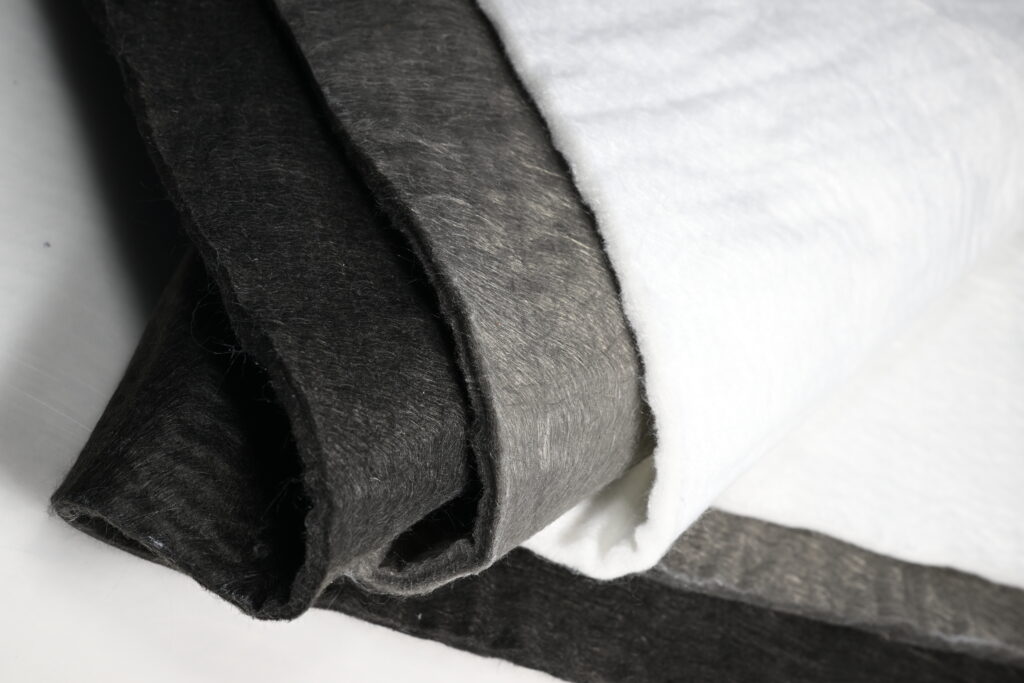What is non-woven geotextile?
Nonwoven geotextile is a material used in civil engineering and environmental applications that is typically made from fibrous materials through methods such as hot melting, needle punching or chemical bonding without the need for traditional weaving or fabric processes.
This makes non-woven geotextiles advantageous in certain applications, such as soil stabilization, waterproofing, anti-penetration, soil protection and environmental protection.
The following are the main features and application areas of non-woven geotextiles:
Anti-infiltration and waterproofing: Non-woven geotextiles are often used to create an impermeable layer to prevent moisture from penetrating into the soil or underground structures. It can be used as waterproofing material in projects such as dams, embankments, ponds, tunnels and sewage treatment facilities.
Soil stabilization: In roads, railways, airports and foundation projects, non-woven geotextiles can be used to reinforce and stabilize soil and prevent soil erosion and settlement.
Environmental protection: Non-woven geotextiles can be used to prevent soil erosion and protect rock retaining walls, coastlines and river banks to reduce environmental impact.
Lawn and floor reinforcement: In places such as lawns, parking lots, sidewalks and open courtyards, non-woven geotextiles can be used to reinforce and stabilize the ground, reducing settlement and weed growth.
Soil protection: In agriculture and horticulture, non-woven geotextiles can be used for soil protection to prevent water evaporation, weed growth and soil erosion.
Filtration layer: Non-woven geotextiles can also be used as geofiltration layers in drainage systems, drainage channels and underground drainage projects to filter and remove excess water.
Construction Protection: In building construction, non-woven geotextiles can be used to protect underground pipes, cables and infrastructure from damage and leakage.
The selection of nonwoven geotextiles depends on specific project requirements, environmental conditions and desired performance characteristics. It often provides a cost-effective solution to improve land use and maintain infrastructure.
Non-woven geotextile price
The price of non-woven geotextiles varies based on a variety of factors, including material type, thickness, specifications, brand, market region and purchase quantity. The following are some of the main factors that affect the price of non-woven geotextiles:
Material Type: Non-woven geotextiles can be made using different types of synthetic fiber materials such as polypropylene, polyester, polyethylene, etc. The cost of different materials will vary, thus affecting the price.
Thickness and specifications: Non-woven geotextiles are available in different thicknesses and specifications. Generally, the thicker and higher the specifications, the higher the price because these specifications usually require more raw materials.
Brand: Well-known brands of nonwoven geotextiles will generally be more expensive because they typically offer higher quality and performance guarantees. But there are also some budget brands that offer relatively cheap options.
Market region: Market prices will also vary in different regions and countries. Logistics costs, market competition and regional economic conditions will all affect prices.
Purchasing Quantity: Generally speaking, purchasing in larger quantities can result in more competitive prices. Suppliers may offer discounts or wholesale pricing, especially for large-scale engineering projects.
Special Requests: If special custom specifications, colors, or performance features are required, these additional special requests may increase the price.
Due to the diversity of these factors, it is difficult to provide an accurate price range. It is recommended that you contact the supplier or manufacturer with specific project requirements to obtain a quote specific to your needs.
Additionally, comparing price and product quality from different suppliers is a critical step in choosing the right nonwoven geotextile for your project.

Non-woven geotextile specifications
Nonwoven geotextile specifications can vary based on specific engineering needs and applications. The following are some common nonwoven geotextile specifications, but please note that these are examples only and actual specifications may vary by supplier and region:
Thickness: The thickness of non-woven geotextile is usually expressed in grams (g/m²). Common thicknesses range from 100 g/m² to 800 g/m² or more. Thicker geotextiles are typically used in projects that require greater strength and durability.
Width: Non-woven geotextiles are usually sold in rolls, and their width can be customized as needed. Standard widths are usually 3.0 meters, 4.0 meters, 6.0 meters or wider.
Color: Non-woven geotextiles are typically black or white, but other colors are available to meet special project needs. Color is often related to material type and use.
Tensile strength: The tensile strength of non-woven geotextiles is a key indicator, and geotextiles of different specifications may differ significantly in this regard. Specifications are usually expressed in kN/m (kilonewtons/meter).
Water permeability: The water permeability of non-woven geotextiles is also an important indicator for drainage applications. Specifications are usually expressed in terms of flow rate (L/m²/s) or water permeability coefficient (k value).
Chemical resistance: Some nonwoven geotextiles may need to be chemically resistant, depending on the specific requirements of the project.
UV stability: For outdoor applications, the UV stability of non-woven geotextiles is also a key factor to ensure that it does not break down easily under sunlight.
Environmental certification: In some projects, non-woven geotextiles may be required to meet specific environmental standards and certifications.
These specifications will vary depending on the nature and specific requirements of the project.
When selecting a nonwoven geotextile specification, selections typically need to be made based on engineering design, geographic conditions and required performance characteristics, while working with suppliers to ensure the appropriate product specifications are selected.

